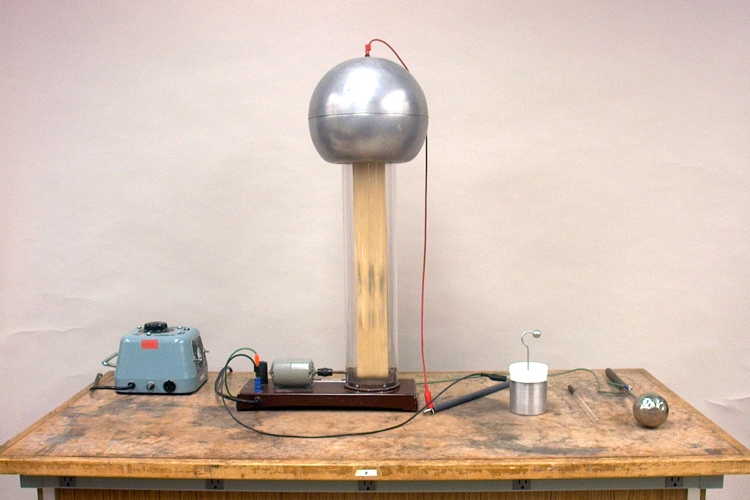
A video of this demonstration is available at this link.
Turn on the Van de Graaff generator. With the outer can of the Leyden jar grounded (either to the base of the generator or to the ground connection of an outlet), charge the Leyden jar by using the grey plastic rod to touch the red alligator clip to the electrode attached to the inner can. Discharge the Leyden jar by bringing the ball of the grounded wand near the ball electrode of the Leyden jar. This will draw a spark. Charge the Leyden jar again. Now, with the clear plastic rod, lift the inner can out of the Leyden jar by the hook near the ball electrode, and set it down on the table. Now lift the plastic cup out of the outer can. Handle both cans and the plastic cup. Replace the plastic cup inside the outer can. Use the plastic rod to lift the inner can by the hook, and then lower it into the Leyden jar. Now bring the grounded wand near the ball electrode of the Leyden jar. It will again discharge with a spark. Important! Always use the grounded wand to turn the generator on and off.
A Leyden jar is a type of capacitor, usually made of a cylindrical container, such as a jar or tube made of glass or plastic, whose inside and outside are covered with either a layer of metal foil, or a thin layer of metal deposited on the surface. The wall of the jar or tube acts as a dielectric between the two metal surfaces. The Leyden jar in this demonstration is a “dissectible” Leyden jar; that is, it can be disassembled and reassembled. The dielectric is a plastic cup, and instead of foil or coatings, the inner and outer plates are metal cans. The outer can has a lip, to which you can attach an alligator clip, and the inner can has attached to it a vertical rod with a hook and a ball electrode at the end.
When you charge the Leyden jar to a high voltage (that is, high potential difference between the two cans), if you bring the ball of the grounded wand near the ball electrode of the Leyden jar, breakdown of the air between the ball electrode and the ground wand occurs, and the Leyden jar discharges in an impressive arc.
If you again charge the Leyden jar to a high voltage, and now use the plastic rod to lift the inner can out of it, you can then lift the plastic cup out of the outer can. You can now handle all three parts without getting shocked. Now replace the plastic cup in the outer can, and then use the plastic rod to lift the inner can and replace it inside the cup. When you bring the ball of the ground wand near the ball electrode, the Leyden jar discharges in an arc to the ground wand.
This demonstration involves some subtleties. The obvious question is why you can handle the separate components of the Leyden jar that you disassembled after you had charged it, but when you reassemble the Leyden jar, it carries a great enough charge to produce an arc when you discharge it with the grounded wand. The obvious answer is that the charge in the Leyden jar resides on the dielectric, but this is true only for the disassembled Leyden jar, and only because of the special way in which you do this demonstration. As you lift out the inner metal can, the charge is transferred to the inside surface of the plastic cup, and little charge remains on the outer can as you pull the plastic cup out of it. In order for this to happen, the Leyden jar must be charged to a sufficiently high voltage (which it is for this demonstration).
Benjamin Franklin, in his studies of capacitance, performed a variety of experiments with dissectible Leyden jars. You can find a description of these experiments, with an analysis of the physics, in Gross, B. American Journal of Physics 12, 324 (1044) (On the Experiment of the Dissectible Condenser). John Zeleny discusses the physical processes involved in the operation of a dissectible Leyden jar, Benjamin Franklin’s experiments, and his own experiments with Leyden jars, in Zeleny, John. American Journal of Physics 12, 329 (1944) (Observations and Experiments on Condensers with Removable Coats). In response to a comment by G. Bradley Huff, in which he claims that the correct answers to standard physics problems involving the removal of dielectrics from parallel-plate capacitors are at odds with reality, Bruce H. Morgan notes, in The Physics Teacher 24, 460 (1986), that this is not the case. Immediately after the note by Bruce H. Morgan, follows a note by Julius Sumner Miller, on the dissectible Leyden jar demonstration. (The content at these links is available to anyone who is using a computer that is on the UCSB network.)